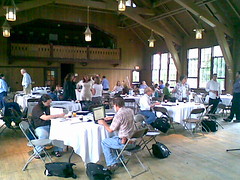Site of the ContentDM User Group Meeting, held at Reed College in late July. This two-day meeting featured panel discussions from a variety of librarians and how they were using ContentDM for their digital collections, for everything from electronic theses and dissertation collections to highlighting historical collections and other community resources. For instance, some libraries are using more audio material (using embedded audio players) to play recordings of spoken languages, such as this transcribed Innu legend.
It was great exchanging ideas and seeing what everyone was doing.
More information from this conference can be found on the
ContentDM Wiki and the meeting blog.
Monday, August 6, 2007
Random interesting sites
Interesting things being discussed on other sites/blogs:
Preservation and archiving of digital media, particular of film:
Library of Congress Preserving Digital Content
National Archives Partners with CreateSpace and Amazon to Digitize Movies
Reframe Project
Make a donation, save a film
Academic Film Archive of North America
Narrative and storytelling
Ira Glass on storytelling
Other kinds of storytelling
What happens when they come for us?: Murdoch buys the Dow Jones
From ResourceShelf
New program color-codes text in Wikipedia entries to indicate trustworthiness
The Cyberchondriacs: How Often Do U.S. Adults Search for Health Care Information Online?
Preservation and archiving of digital media, particular of film:
Library of Congress Preserving Digital Content
National Archives Partners with CreateSpace and Amazon to Digitize Movies
Reframe Project
Make a donation, save a film
Academic Film Archive of North America
Narrative and storytelling
Ira Glass on storytelling
Other kinds of storytelling
What happens when they come for us?: Murdoch buys the Dow Jones
From ResourceShelf
New program color-codes text in Wikipedia entries to indicate trustworthiness
The Cyberchondriacs: How Often Do U.S. Adults Search for Health Care Information Online?
Culture Code
It happened AGAIN. I keep meaning and meaning to post, and then I don't, feeling like I need to get the post completely together in my head (and "on paper" with full references) before I post. I am still learning to think of the blog as a posted email versus a formal written document.
In any case, I have been meaning to write about a very interesting book I read lately: The Culture Code: An Ingenious Way to Understand Why People Around the World Live and Buy as They Do, by Clotaire Rapaille. Although focused on marketing (which I have generally viewed as something only undertaken by those in the darkest corners of the business world), it has much to inform those of us working with usability issues. Why DO people do what they do?
Rapaille was born and raised in France, but immigrated to the United States in the 1970s. This background allows him to be immersed in, and also removed from, two cultures, informing his work. He has primarily been hired by companies (like GM, etc.) interested in understanding how their branding is or is not working.
What is fascinating about Rapaille's work (and how he justified his ROI to the companies hiring him) is that he just doesn't ask people what they like or do not like about a product. As the fictional Gregory House might say, "Everybody lies". Rapaille doesn't think people will lie deliberately to focus groups, but there is an overwhelming skew on the part of participants trying to supply (unconsciously most of the time) with the answers they THINK the researchers want to hear.
Rapaille's approach is quite different. His sessions are broken into three sessions. In the first hour he asks people to consider that he is an alien from another planet and he has never seen of or used coffee/car/insert other product here, then asks them to explain to him what that thing is for. Doing this, he posits, helps understand all the ways in which that thing is or is not useful/meaningful in people's lives.
The second part of his testing has people doing collage, starting to access the right-side of their brain. Rapaille does this and the next step because he feels that the way people perceive things (i.e. the way a particular product or action of a culture is "coded") depends very much on the emotional imprint associated with that product or action. Things with positive emotional imprints will have positive cultural codes and vice versa.
In the final step of his testing he dims the lights and lays people down on the floor and has them talk about their first, best, or strongest memory associated with that particular thing he is testing. Then he analyzes the essence of what this is about and comes up with a one word "code" that embodies what that thing represents to people in that culture.
He does caution that these codes are cultural generalizations and do not apply across the board to every single individual, but the results are interesting. For instance, in America, a Jeep is coded as "HORSE": something that helps people get out in the wild and feel free. In France and Germany, however, Jeep is coded by those cultures as "LIBERATOR", Rapaille feels because of the association of the Jeep with liberating American forces in WWII.
He covers things like coffee and make-up, but also more non-product things, like how a culture views shopping, food, alcohol, and even the American presidency (apparently we don't just want a father figure - we want Moses!)
While at first glance this may have nothing to do with usability, Web sites, or instructional design, I think it has a lot to inform us about how things become imprinted in people's associations and how far we may have to dig to get the information we really need to create the interfaces that will work the best for the majority of the patrons in our particular "culture". What "CODE" do they have? How can we make these embedded codes work for us? Are we doing things inadvertently to work against them in an unknowingly negative way? These are the questions this book made me think about.
In any case, I have been meaning to write about a very interesting book I read lately: The Culture Code: An Ingenious Way to Understand Why People Around the World Live and Buy as They Do, by Clotaire Rapaille. Although focused on marketing (which I have generally viewed as something only undertaken by those in the darkest corners of the business world), it has much to inform those of us working with usability issues. Why DO people do what they do?
Rapaille was born and raised in France, but immigrated to the United States in the 1970s. This background allows him to be immersed in, and also removed from, two cultures, informing his work. He has primarily been hired by companies (like GM, etc.) interested in understanding how their branding is or is not working.
What is fascinating about Rapaille's work (and how he justified his ROI to the companies hiring him) is that he just doesn't ask people what they like or do not like about a product. As the fictional Gregory House might say, "Everybody lies". Rapaille doesn't think people will lie deliberately to focus groups, but there is an overwhelming skew on the part of participants trying to supply (unconsciously most of the time) with the answers they THINK the researchers want to hear.
Rapaille's approach is quite different. His sessions are broken into three sessions. In the first hour he asks people to consider that he is an alien from another planet and he has never seen of or used coffee/car/insert other product here, then asks them to explain to him what that thing is for. Doing this, he posits, helps understand all the ways in which that thing is or is not useful/meaningful in people's lives.
The second part of his testing has people doing collage, starting to access the right-side of their brain. Rapaille does this and the next step because he feels that the way people perceive things (i.e. the way a particular product or action of a culture is "coded") depends very much on the emotional imprint associated with that product or action. Things with positive emotional imprints will have positive cultural codes and vice versa.
In the final step of his testing he dims the lights and lays people down on the floor and has them talk about their first, best, or strongest memory associated with that particular thing he is testing. Then he analyzes the essence of what this is about and comes up with a one word "code" that embodies what that thing represents to people in that culture.
He does caution that these codes are cultural generalizations and do not apply across the board to every single individual, but the results are interesting. For instance, in America, a Jeep is coded as "HORSE": something that helps people get out in the wild and feel free. In France and Germany, however, Jeep is coded by those cultures as "LIBERATOR", Rapaille feels because of the association of the Jeep with liberating American forces in WWII.
He covers things like coffee and make-up, but also more non-product things, like how a culture views shopping, food, alcohol, and even the American presidency (apparently we don't just want a father figure - we want Moses!)
While at first glance this may have nothing to do with usability, Web sites, or instructional design, I think it has a lot to inform us about how things become imprinted in people's associations and how far we may have to dig to get the information we really need to create the interfaces that will work the best for the majority of the patrons in our particular "culture". What "CODE" do they have? How can we make these embedded codes work for us? Are we doing things inadvertently to work against them in an unknowingly negative way? These are the questions this book made me think about.
Labels:
books,
branding,
marketing,
sociology,
usability testing
Subscribe to:
Comments (Atom)



